Building a Baseball Team Through Free Agents Versus Homegrown Talent
There are generally three ways of bringing new players into a baseball organization: trades, free agency, and amateur signings, either through the draft or international free agent market. There isn’t necessarily a “best” way, as successful teams are built using a wide variety of methods. The table below shows WAR totals for the first half of the season split into the three categories above, along with waivers and Rule 5 picks, which constitute a very small portion of the total:

As the chart shows, homegrown talent and players acquired through trade come out pretty far ahead of free agency. In terms of the sheer number of players, there are over 400 in each of the homegrown and trade sections, with around 300 in free agency. As for the impact, it’s hard to argue with the importance of homegrown players when looking at the graph above. Breaking the homegrown section down, we can see how each team has done this season with players they’ve drafted or signed internationally and then developed in their organization:

Generally, we see good teams with high numbers and bad teams with low numbers, though the Mets and Yankees provide two counterexamples. It’s easy to see why the Twins have done so well this year as their young talent from the draft and international signings has taken off. Milwaukee and Oakland might be considered surprisingly low given their small market reputations, though trades make up a good portion of their WAR this season. The next two graphs show the same numbers as above, except divided into the draft and international amateur signings:

This list isn’t too far from the one above, as around 80% of the homegrown WAR comes from the draft. Here’s the international side:

We can see the Twins have done very well both domestically and internationally this season, with the left side of the Red Sox infield doing a lot of work and the Braves young stars playing very well. While the above graphs show raw numbers, the next graph shows the percentage of a team’s WAR coming from homegrown payers:
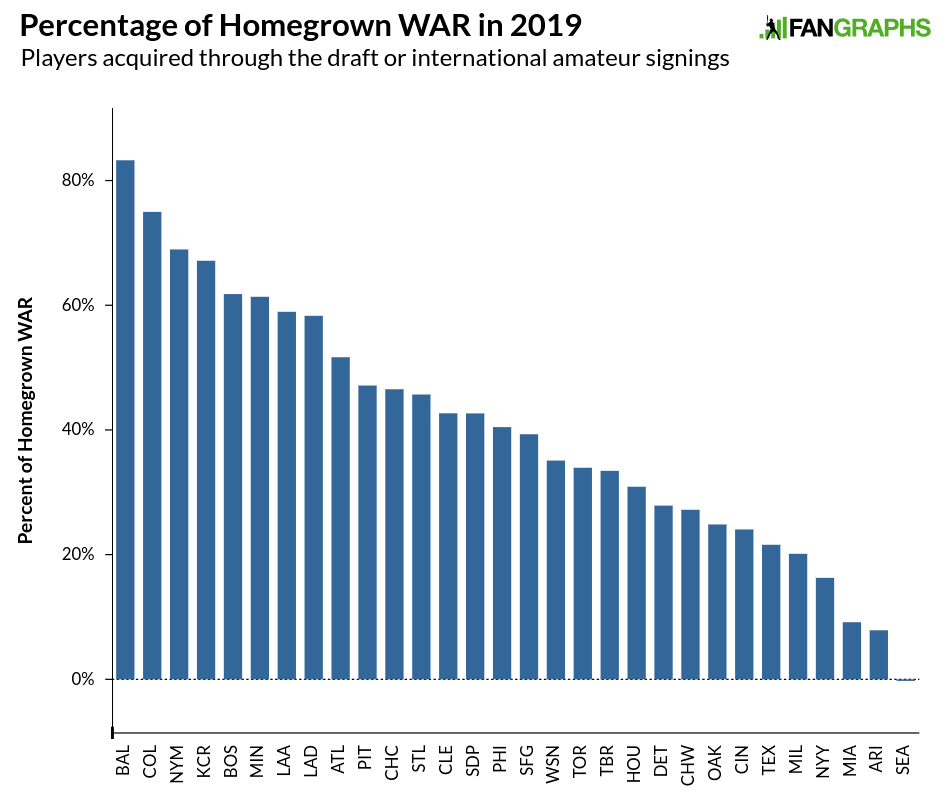
The top of this list shows that having exclusively homegrown players isn’t really the way to success. The most successful teams near the top of that list, including the Red Sox, Twins, Dodgers, and Braves, are still only around the 60% mark, meaning they get about 40% of their WAR elsewhere. One such avenue is trades. Here are the WAR leaders this season for players acquired via trade:
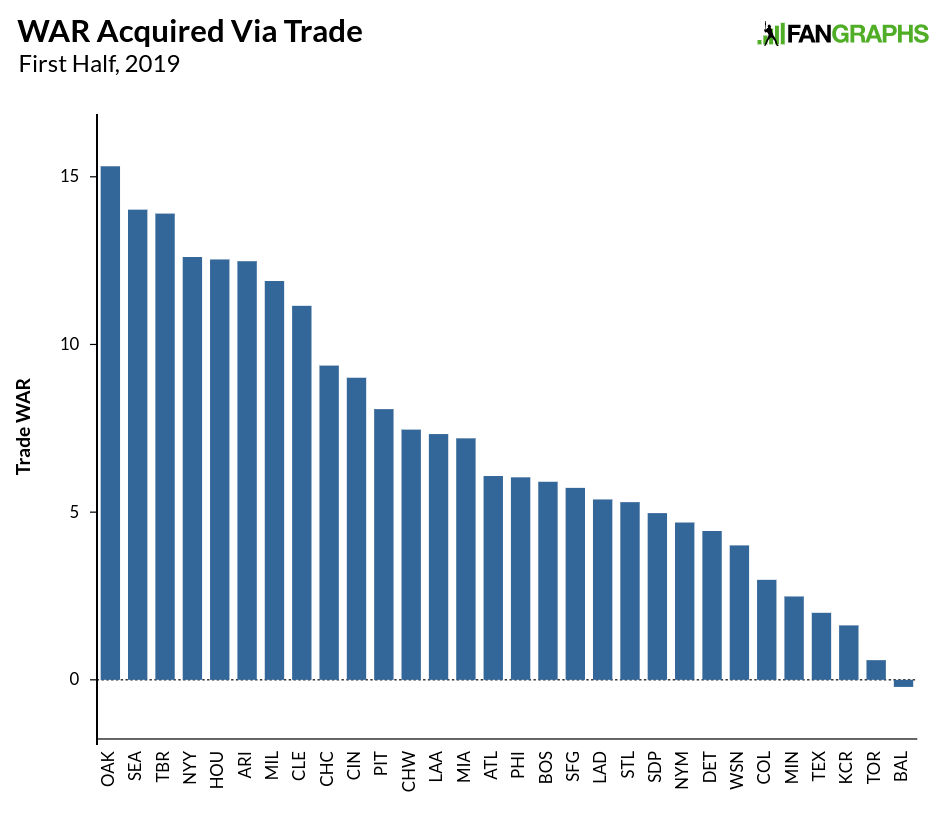
The Mariners were dead last in homegrown WAR, but Jerry Dipoto has very much earned his trade-happy reputation; most of the Mariners’ WAR this season has come from players acquired from outside the organization.
Billy Beane is no stranger to trades, and the Tampa Bay Rays once inspired this tweet.
LOVE this trade for the Rays. Who'd they give up? And who'd they get?
— Sam Miller (@SamMillerBB) January 22, 2014
While the Yankees might have the reputation of being a team built on youngsters from within, some of those young players, like Gleyber Torres, Luke Voit, and Domingo German came in trades, as did the winter’s big acquisition in James Paxton. Here’s how the percentages stack up:
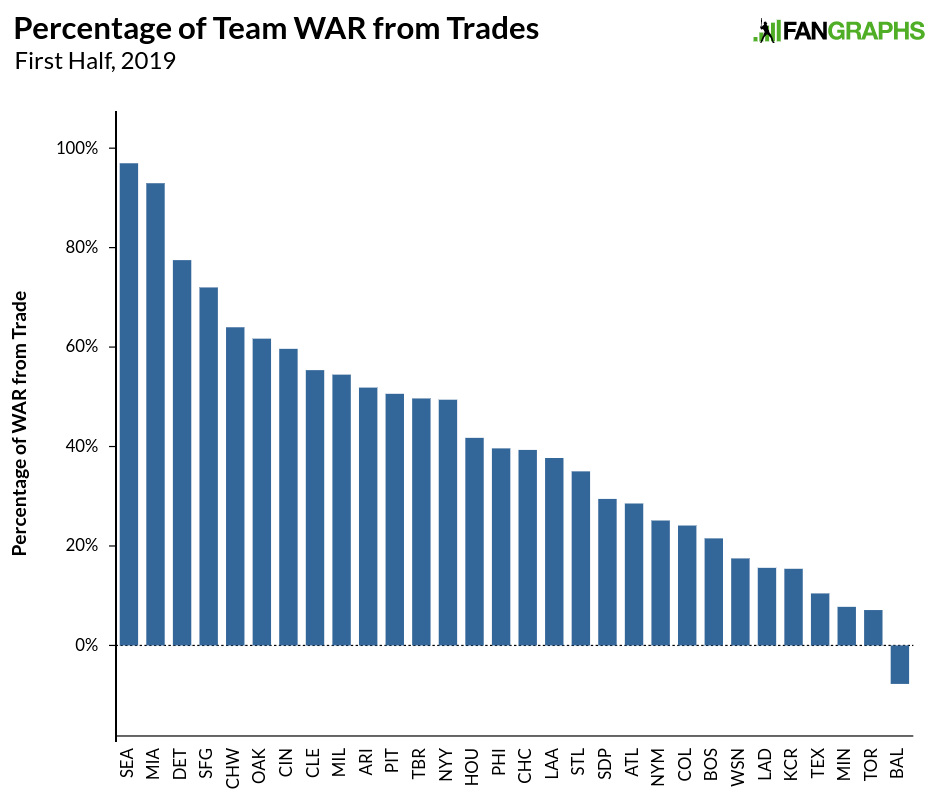
Trade aren’t all made with the same purpose. Yoan Moncada and Chris Sale have both been worth about three wins this season, but the Red Sox acquired Sale to win now, while Moncada moved to the White Sox with an eye to the future. Of the three main avenues to acquiring players, looking at trades is the least instructive when compared to the standings.
Free agency has been much maligned of late, but here are the results of teams’ recent free agent spending:

The Rangers have gotten great performances from Lance Lynn and Mike Minor this season on their way to a surprising first half. The Nationals have long been major players in free agency, while the Dodgers and Yankees have always spent money, even if they have slowed down of late. Here’s what the WAR looks like as a percentage of a team’s total WAR so far this season:

The Rangers still top the list, though it is important to note that this graph is not on the same scale as the trade and homegrown graphs above. The lower percentage should be expected given the smaller percentage of WAR that comes from free agency. While the percentages are smaller, there are a lot of contending teams getting a significant percentage of their contributions from free agency. I mentioned above that looking at WAR from trades was the least instructive when it came to winning this season. To further illustrate that notion, the graph below shows homegrown WAR and first half winning percentage:
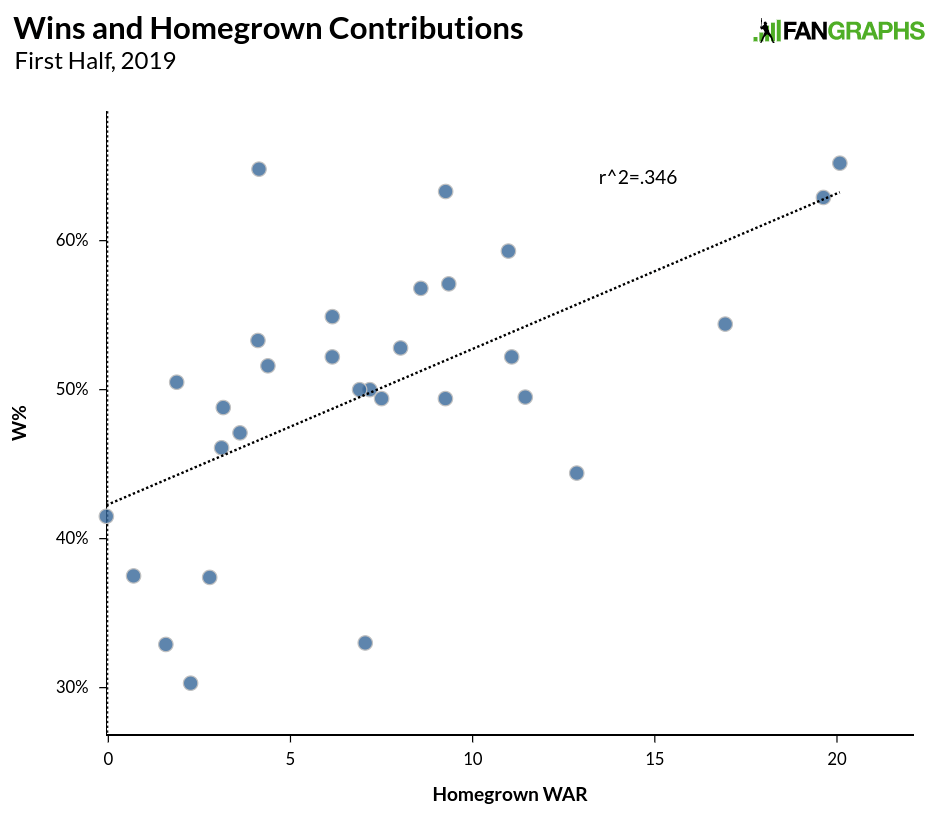
We might not see a crystal clear pattern; the r-squared of around .35 is a pretty high number. The more WAR a team gets, the more wins they are likely to achieve. This might seem a bit obvious, but the r-squared for the traded players’ team WAR was half the homegrown one. Now, here are free agent wins and WAR:
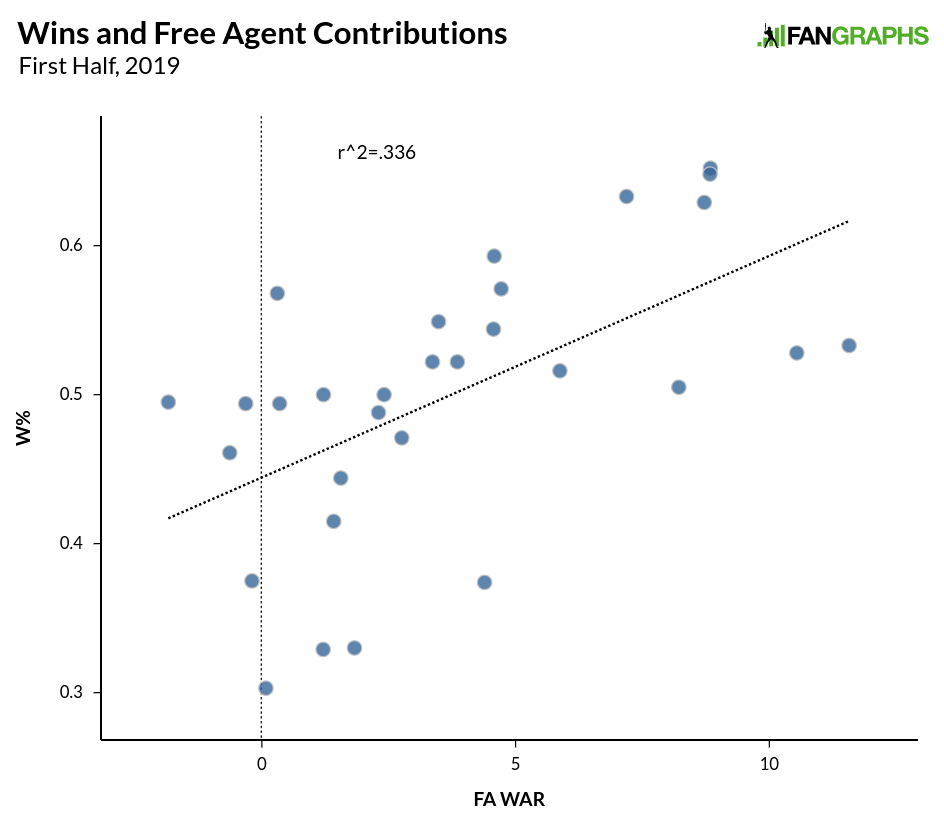
The correlation is nearly identical for free agent WAR and homegrown WAR. This seems a little odd given that free agent WAR sits at half that of homegrown WAR, but it appears from these graphs that succeeding in free agency is just as important to winning as getting good homegrown contributions. This doesn’t mean that teams have to spend a ton of money in free agency, but they need to be successful there and can’t ignore it as a means of talent acquisition. Money is the easiest way to bring in talented players through free agency, and even the Brewers, Rays, and Twins spent some money in free agency this past offseason. Teams that expect to be successful in the coming season should be more likely to spend in free agency, so some of this is a self-fulfilling prophecy, but it also shows that teams trying to win can and should supplement their rosters in the free agent market if they want to be successful.
The last graph was a bit surprising, so I ran one more correlation. This time, I took the standard deviation of the percentages for each team’s homegrown WAR, traded WAR, and free agent WAR. The idea was to try and find the most balanced teams when it comes to acquiring players. The lower the standard deviation, the more balance when it comes to the source of a team’s production. This is what I found:
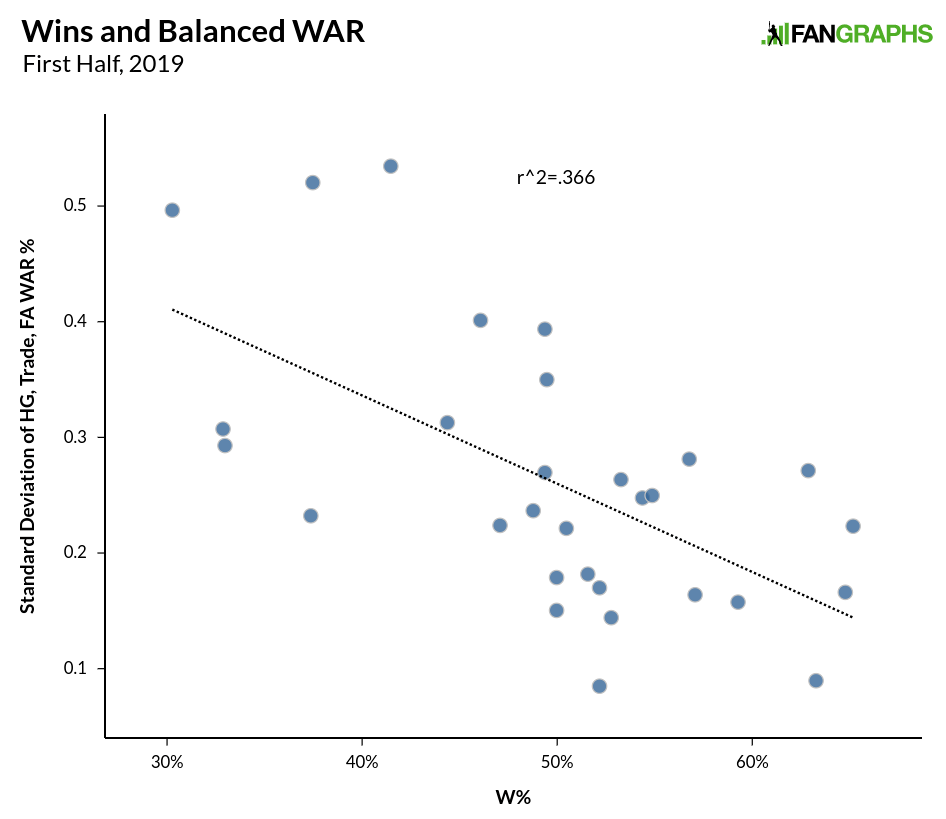
The more balanced teams are the more successful ones. There might not be a right way to build a team, but for at least one half of baseball this year, getting production from the draft and international signings, free agency, and trades is important. A larger study covering multiple seasons, both individually and together, would be a welcome addition to the one here, but overall, good teams aren’t as reliant on homegrown players as we might think, as they tend to find talented players wherever they may be.
Craig Edwards can be found on twitter @craigjedwards.

Is a gooderly thing to look at. Will that followup study be happening? Pretty tough to draw meaningful conclusions from half a season of results